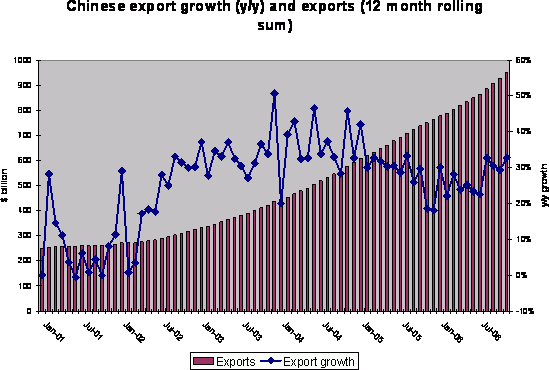Modest ascent of yuan v. dollar fails to pinch Chinese exporters …
More on:
I don’t usually do press criticism, but I really didn’t like James Areddy’s Wall Street Journal story about how the yuan’s 6% rise (v. the $) since mid 2005 is starting to cut into Chinese exports (and the profit margins in the export sector). Areddy’s lead is “The Chinese currency’s rising value has started to pinch an increasing number of businesses here, eroding already thin profit margins, forcing them to reduce expenses and sometimes costing them business.”
The argument is backed by a series of anecdotes. What the story lacks, in my view, is any supporting data. And there are no shortage of anecdotes telling the opposite story. And in this case, the broader data still supports a “strong export growth story” not a “slowing export growth” story.
Here is what I think Areddy left out.
The yuan depreciated over the course of 2006 against the euro, pound, other European currencies, the Korean won, the Thai baht, the Philippine peso, the Indonesian rupiah and pretty much all of Asia other than Japan.
On a broad trade weighted basis, the RMB appreciated in 2005 because the dollar rose, but was basically flat in 2006. If Chinese exporters are being pinched by the RMB’s rise v. the $, aren’t they getting a windfall in Europe? Remember, Chinese exports to Europe are growing faster than Chinese exports to the US (using US and European import growth data as a proxy for Chinese export growth -- a trick that helps deal with shipments through Hong Kong). China now exports as much to Europe as with the US.
The contribution of net exports to Chinese GDP growth has increased since mid 2005. I won’t go through the argument again. Just read Nick Lardy. Or look at any credible macroeconomic analysis. Net exports added 3% to Chinese GDP growth in q3.
There is no sign in the macroeconomic data of any slowdown in Chinese exports. In the 12months prior to June 2005 (when the yuan was stable), China exported about $680b and ran a $80b trade surplus. In the most recent twelve months (November 2005-November 2006), China exported $950b and ran a $165-170b trade surplus.
Moreover, the pace of China’s export growth seems to have accelerated recently. It was slowly falling down from the 30-40% levels of 2003 and 2004 (during the RMB’s big depreciation) and looked to be heading toward say 20%. But then export growth accelerated back to around 30% y/y.

China’s trade surplus is also rising …

And Chinese goods exports have now caught up with US goods exports.

The Chinese data is not seasonally adjusted and the US data is, but seasonal adjustment wouldn't change things much.
And with an export base that is as big as the US, 30% y/y export growth really means something. Continued 30% growth off a $950 base implies $275b in Chinese additional exports in 2007 …
I doubt the current pace can be sustained no matter what happens to the RMB, but China is going into the year with a lot of export momentum.
It is possible that the recent acceleration in the pace of RMB appreciation could lead to a significant slowdown, even if the RMB’s appreciation v. the $ has been largely offset the dollar’s depreciation against the euro. It is also possible that China only managed to achieve the recent acceleration in export growth by squeezing margins. But if so, Areddy needs to build that case.
Clearly some firms in China are starting to complain about the rising yuan. But finding firms in China that complain about the yuan is kind of like finding firms in the US that complain about rising interest rates. It is important to put their complaints in context. And right now, the context is strong and accelerating export growth.
More on:
 Online Store
Online Store